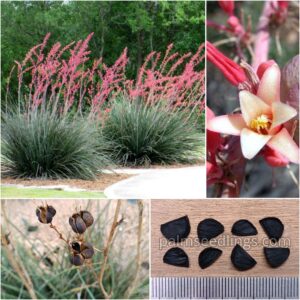Menu
6,00 € – 35,00 €
Product Details
Pandanus utilis, commonly known as the Screw Pine or Pandan Tree, is a distinctive tropical plant recognized for its spiral arrangement of long, spiky leaves and aerial prop roots. Native to Madagascar and widely distributed in tropical regions, this evergreen tree has cultural, ornamental, and practical uses.
-Germination Rate: High
-Germination Time: Medium/Slow
-Germination Difficulty: Medium
-Growth speed: Medium
Select Quantity
*Shipping cost is calculated automatically in the cart after adding the products.
Pandanus utilis (Screw Pine or Pandan Tree)
Habitat:
Indigenous to a variety of tropical habitats, the Screw Pine thrives in well-drained soils, often found in coastal areas, mangroves, and tropical rainforests. It is well-adapted to saline conditions and is commonly planted along coastal regions for erosion control.
Outstanding Features:
The most outstanding feature of the Screw Pine is its unique spiral arrangement of long, strap-like leaves. The leaves are tough and spiky, creating a distinctive appearance. The tree also develops aerial prop roots that provide support and stability. The fruit produced by female plants is a large, compound structure with edible seeds.
General Appearance:
With a mature height typically reaching 20 to 40 feet, the Screw Pine has a symmetrical and cone-shaped crown. The trunk is often short and stout, and the aerial prop roots radiate from the base, giving the tree additional support. The leaves emerge in a spiral pattern, creating a striking architectural effect.
Applications:
The Screw Pine is valued for various purposes. In some cultures, the leaves are used for weaving traditional mats and baskets. The edible seeds from the fruit are sometimes consumed. The tree is also planted for landscaping in tropical gardens, parks, and along coastal areas for erosion control. Its unique appearance adds an exotic touch to landscapes.
Adaptability:
Adaptable to a variety of well-drained soil types, the Screw Pine prefers full sun to partial shade and is tolerant of salt spray. It is well-suited for tropical climates, thriving in regions with high temperatures and humidity. Its adaptability to coastal conditions, combined with its distinctive form, makes it a popular choice for both practical and ornamental purposes in tropical landscapes.
| Weight | N/A |
|---|---|
| Quantity | 10 Seeds, 100 Seeds, 1.000 Seeds |

All rights reserved PalmseedlingsⓇ 2025.